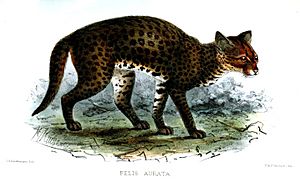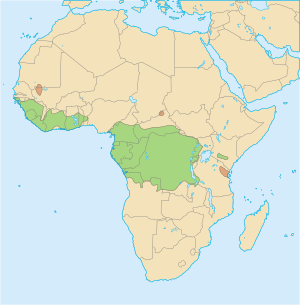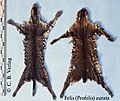African golden cat facts for kids
Quick facts for kids African Golden Cat |
|
|---|---|
 |
|
| Conservation status | |
| Scientific classification | |
| Kingdom: | |
| Phylum: | |
| Class: | |
| Order: | |
| Family: | |
| Subfamily: | |
| Genus: |
Profelis
(Severtzov, 1858)
|
| Species: |
P. aurata
|
| Binomial name | |
| Profelis aurata (Temminck, 1827)
|
|
| Subspecies | |
|
|
 |
|
The African golden cat (Profelis aurata) is a medium-sized cat. It usually weighs about 28 kilograms (62 pounds). The fur on its chest and chin is often light-colored. Sometimes, it can even be pure white.
Sadly, this cat is in danger. Its home is being destroyed by deforestation (when forests are cut down). It is also hunted for bushmeat. Because of these threats, it is listed as Vulnerable on the IUCN Red List. This means it could become endangered if we don't protect it.
Contents
About the African Golden Cat
African golden cats have special fur. When they are kept in captivity, their fur color can change over time. This change depends on how old they are and other things around them.
Their heads have light spots around their eyes. Studies from the 1960s showed that these cats come in many colors, like red, brown, and silver. These colors are found in equal numbers in most places where they live. Cats in West Africa are special because they have unique spots on their backs.
Where They Live
African golden cats live in tropical forests. You can find them from sea level up to 3,000 meters (9,800 feet) high. They really like thick, wet forests with lots of plants on the ground. They are often found near rivers. However, they can also live in cloud forests, bamboo forests, and high moorland areas.
These cats are found across a large part of Africa. They live from Senegal in the west to Kenya in the east. Their home stretches as far north as the Central African Republic and as far south as northern Angola.
Habits and Lifestyle
African golden cats are very shy animals. Because of this, we don't know much about how they behave in the wild. They live alone and are usually active at dawn, dusk, or night. This means they are crepuscular or nocturnal. But sometimes, they hunt during the day, depending on when their prey is available.
These cats can climb trees, but they mostly hunt on the ground. They eat small animals like tree hyraxes and rodents. They also hunt birds, small monkeys, and small antelopes called duikers. Sometimes, they even catch young giant forest hogs. They have also been known to take farm animals like chickens and other livestock.
Babies and Family Life
Most of what we know about African golden cat babies comes from cats living in zoos. They have babies easily in captivity. Their kittens grow and develop very quickly compared to other small cats. One kitten was able to climb a 40-centimeter (16-inch) wall when it was only 16 days old! This shows how agile they are from a young age.
The kittens' eyes open within a week after they are born. They stop drinking their mother's milk when they are 6 to 8 weeks old. Female cats can have their own babies when they are 11 months old. Males, however, need to be about 18 months old before they can breed.
In captivity, these cats can live up to 12 years. We don't know how long they live in the wild.
Dangers They Face
The African golden cat is in danger because its home, the tropical rainforest, is being destroyed. These forests are being cut down to make farms for oil palm trees. They are also being cleared for mining and building roads. All of this destroys the places where the cats live. They are also hunted for bushmeat, especially in the Congo Basin area.
Protecting Them
Many countries have laws to protect African golden cats. Hunting them is against the law in Angola, Benin, Burkina Faso, Congo, Côte d'Ivoire, Democratic Republic of Congo, Ghana, Kenya, Liberia, Nigeria, Rwanda, and Sierra Leone. In Gabon, Liberia, and Togo, there are special rules for hunting to help protect these cats.
Images for kids
See also
 In Spanish: Gato dorado africano para niños
In Spanish: Gato dorado africano para niños




